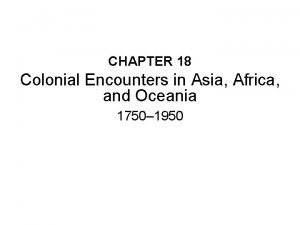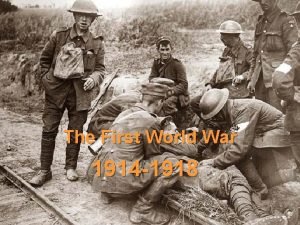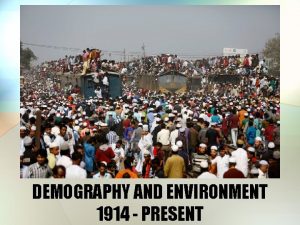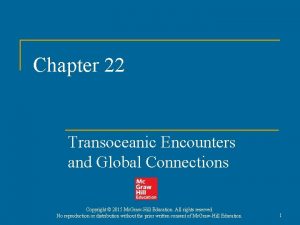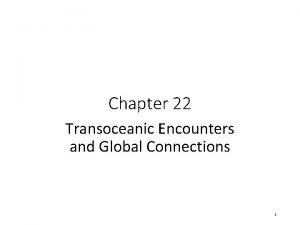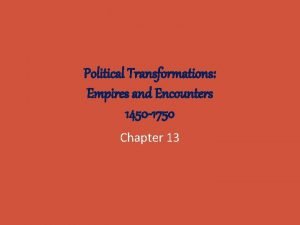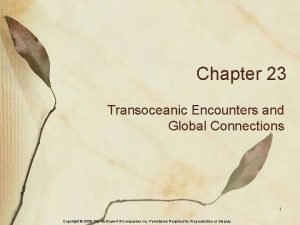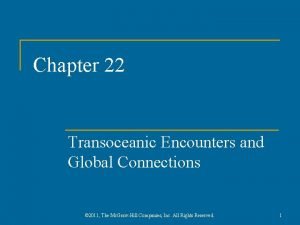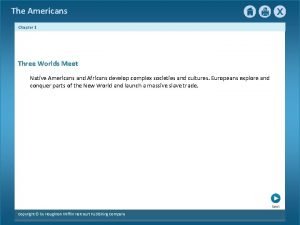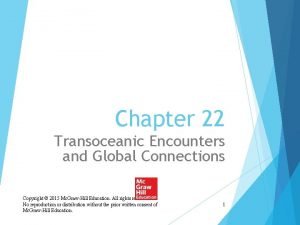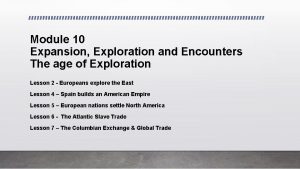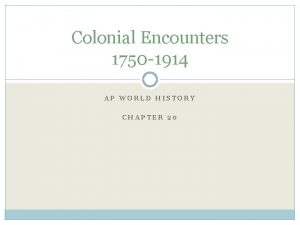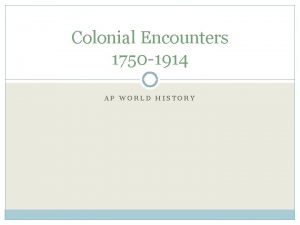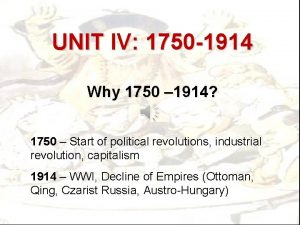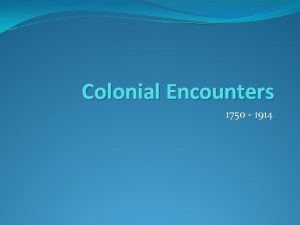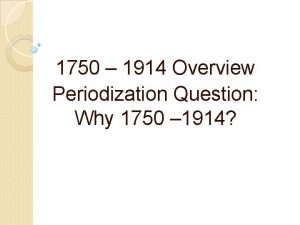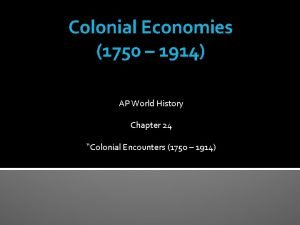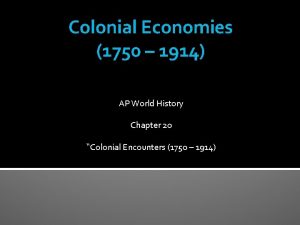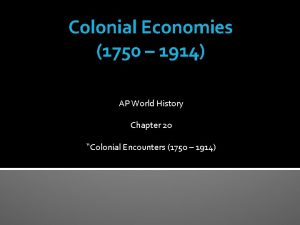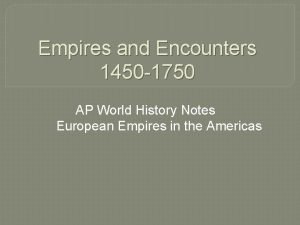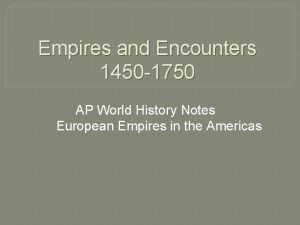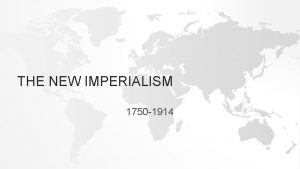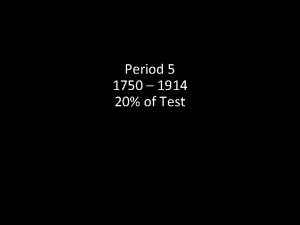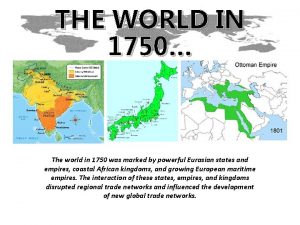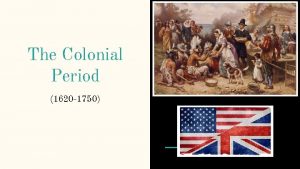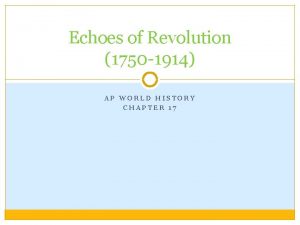Colonial Encounters 1750 1914 AP WORLD HISTORY CHAPTER





















- Slides: 21

Colonial Encounters 1750 -1914 AP WORLD HISTORY CHAPTER 20

A Second Wave of European Conquests First Wave of European Colonialism Second Wave of European Colonialism 1500 s - 1600 s 1750 – 1900 In the Western Hemisphere (Americas) In Africa and Asia Spain and Portugal = were major players; NOT ANYMORE DUN DUN New countries involved = Germany, Italy, Belgium, the U. S. , Japan Devastated native populations No massive devastation done to native peoples Europeans chose the path of conquest and outright colonial rule Europeans preferred informal control (cheaper & less likely to cause war) � Construction of 2 nd-wave European empires in Africa and Asia involved military force or the threat of using it � Although they would have preferred non-violent takeovers, Europeans often had to fight in wars of conquest to create their empires � Always won in the end superior militaries and weapons

Colonial Asia in the Early 20 th Century

Colonial Africa in the Early 20 th Century

Various Paths to Colonial Status �India and Indonesia = colonial conquest grew out of earlier interactions with European trading companies British authorities meeting with Mughal leaders India = became controlled by Britain Indonesia = became controlled by the Dutch Neither country had a clear-cut plan for conquest Conquest evolved slowly as local authorities and European traders made and unmade a variety of alliances Acquisition of India and Indonesia = fairly easy because both were fragmented territories with no political unity

Various Paths to Colonial Status �Australia and New Zealand = both taken over by the British Similar to the earlier colonization of North America Conquest accompanied by: massive European settlement and diseases that reduced native numbers Became settler colonies = “neo-European” societies in the Pacific White Settlers in Australia

Various Paths to Colonial Status �Africa, mainland Southeast Asia, and the Pacific islands = occurred later = in the 2 nd half of the 19 th century More abruptly and deliberately than anywhere else

The “Scramble for Africa” � Until the 1800 s = Europeans knew very little about Africa � 1840 = David Livingstone went to Africa Traveled around and explored there for 30 years He lost contact with the outside world for 6 years in the 1860 s American Journalist Henry Stanley was sent to look for him -- ended up leading several expeditions himself � Journeys of Livingstone and Stanley increased interest in Africa and its many resources Meeting of Livingstone and Stanley

The “Scramble for Africa” � One European country after another began to claim parts of Africa Able to take African territories easily because they had superior weapons and a lot of money � 1885 = the Berlin Conference = Several European nations met in Berlin to decide how to divide up Africa No African leaders invited Peaceful negotiations made between the European powers that officially decided “who got what” � By 1914 = Europeans controlled 90% of Africa The Berlin Conference European powers often had to use extensive and bloody military action to maintain control within their acquired African territories

Varying Responses to European Encroachment � Some tried to enlist Europeans in their own internal struggles for power or in their external rivalries with neighboring states � Some tried to pit imperial powers against each other � Some wanted to fight back against the Europeans � Some believed resistance was futile and acceptance of the situation was the only option � Some negotiated with Europeans in an effort to keep as much independence and power as possible African Resistance to Colonial Rule

Under European Rule: Cooperation �Many groups and individuals willingly cooperated with colonial authorities �Many men found employment, status, and security in the European-led armed forces �Colonial rulers = expensive, in short supply, and could rarely communicate with their subjects Result = local intermediaries needed Local intermediaries = typically from elite or governing families Local intermediaries = could retain their status and gain wealth by exercising authority at the local level

Under European Rule: Cooperation �Many found it beneficial to pursue Western education Western-educated class served the colonial state, European businesses, and Christian missions as teachers, clerks, translators, and lower-level administrators Some with even more education = became lawyers, doctors, engineers, journalists, etc.

Under European Rule: Rebellion �Periodic rebellions (both big and small) = a constant problem for colonial regimes everywhere �Most famous colonial rebellion = the Indian Rebellion of 1857 -1858 Also known as: the Sepoy Rebellion or Sepoy Mutiny Sepoys = Indian soldiers in the service of European powers

Indian Rebellion of 1857 -1858 �Triggered by the introduction into the colony’s forces of a new cartridge smeared with animal fat from cows and pigs �Remember: Indian troops = Hindus and Muslims Hindus = find cows sacred Muslims = regard pigs as unclean Both = viewed this military “innovation” as a plot to harm them and convert them to Christianity �Indian troops in Bengal mutinied against their British superiors

Indian Rebellion of 1857 -1858 �Indian Rebellion spread from Bengal to other regions and other social groups �Many social groups within India were upset with British colonial rule Local rulers = lost power Landlords = deprived of their estates and/or rent Peasants = overtaxed and exploited by urban moneylenders and landlords Weavers = unemployed (displaced by machines) Religious leaders = opposed to Christian missionary preaching

Indian Rebellion of 1857 -1858 �Crushed in 1858 but important results followed: Widening of the racial divide in colonial India between native Indians and their British rulers eroded British tolerance for their subjects British = became more conservative and cautious when it came to trying to change Indian society didn’t want another rebellion British government assumed direct control over India ended the British East India Company’s rule there

Colonial Empires with a Difference �Major factor distinguishing the rulers from the ruled = race �Education for colonial subjects = very limited Limited to practical subjects Europeans were afraid that education and knowledge would lead to power for colonial subjects

Colonial Empires with a Difference �Colonies with large European settler populations = blatant pattern of racial segregation �Example = apartheid Racial segregation in South Africa Racial system provided for separate: “homelands, ” educational systems, residential areas, public facilities, etc.

Colonial Empires with a Difference �European powers were much more involved and “hands on” with their colonial states in the 19 th century European factories on the west coast of Africa Affected the daily lives of people far more than empires had in the past Centralized tax-collecting agencies New modes of transportation and communication Imposed changes in landholding patterns Integration of colonial economies into global trade network Public health and sanitation measures

Colonial Empires with a Difference �European colonizers felt the need to count, classify, and organize their colonial subjects Wanted a way to manage the unfamiliar, complex, varied, and changing societies that they now controlled Made colonial administration easier Ex: In African colonies, Europeans identified and sometimes even invented distinct tribes each with its own territory, language, customs, chief, etc.

Colonial Empires with a Difference �European colonial policies contradicted their own values and practices at home European Nations European Colonies Becoming more democratic Were mostly dictatorships (used to create order and stability) Swept up in nationalism Total opposite of national independence Christian and Enlightenment idea of human equality Racial divisions, ranked racial classifications, etc. Industrialization and modernization Modernization discouraged because Europeans did not want modernization to cause opposition to colonial rule
 Chapter 18 colonial encounters in asia and africa
Chapter 18 colonial encounters in asia and africa Colonial encounters in asia africa and oceania
Colonial encounters in asia africa and oceania Colonial empires 1914
Colonial empires 1914 Colonial empires 1914
Colonial empires 1914 Transatlantic encounters in history of education download
Transatlantic encounters in history of education download Pstuffy bunny
Pstuffy bunny Population of the world 1914
Population of the world 1914 Ap world history chapter 25 africa and the atlantic world
Ap world history chapter 25 africa and the atlantic world Transoceanic encounters and global connections
Transoceanic encounters and global connections Transoceanic encounters and global connections
Transoceanic encounters and global connections Chapter 5 political transformations empires and encounters
Chapter 5 political transformations empires and encounters Chapter 23 transoceanic encounters and global connections
Chapter 23 transoceanic encounters and global connections Chapter 22 transoceanic encounters and global connections
Chapter 22 transoceanic encounters and global connections Traditions and encounters chapter 20
Traditions and encounters chapter 20 Chapter 1 three worlds meet
Chapter 1 three worlds meet Transoceanic encounters and global connections
Transoceanic encounters and global connections French floral design history
French floral design history Georgian floral design
Georgian floral design Bad world tour
Bad world tour Module 10 expansion exploration and encounters
Module 10 expansion exploration and encounters Christ encounters
Christ encounters Encounters and foundations to 1800
Encounters and foundations to 1800
